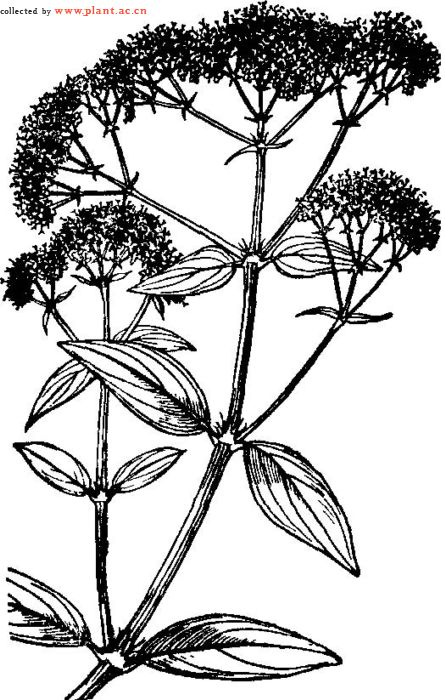广花耳草Hedyotis ampliflora Hance
广花耳草Hedyotis ampliflora Hance
46. 广花耳草(海南植物志)图版11:9-14
Hedyotis ampliflora Hance in Journ. Bot, 17: 11. 1879; Hemsl. in Journ. Linn. Soc. Bot. 23: 373. 1888; Merr. in Lingnan Sci. Journ. 5: 171. 1927; 海南植物志3: 305. 1974; 中国高等植物图鉴4: 215, 图5944. 1975. ——Oldenlandia ampliflora (Hance) Kuntze, Rev. Gen. Pl. 1: 292. 1891.
藤状灌木;老茎光滑无毛;小枝幼时有明显的纵槽,槽内常有短硬毛。叶对生,纸质,披针形或阔披针形,长3.5-7厘米或过之,宽1.5-3厘米,顶端短尖或短渐尖,基部楔形或阔楔形,上面仅在中脉上有稀疏粗伏毛,下面被毛长而硬,罕无毛;侧脉明显,每边3-4条,与中脉成锐角伸出,几乎直伸向上;叶柄略宽,长2-5毫米;托叶被毛或无毛,基部合生,宽阔,顶部撕裂成3-5条刚毛状的裂片。花序顶生,为伞房花序式排列的聚伞花序,有长2-3.5厘米的总花梗;苞片微小或缺;花4数,有长1-3毫米的花梗;萼管半球形或陀螺形,长1-1.4毫米,萼檐裂片披针形,具羽状脉,与萼管等长或略长,顶端短尖,花后外反;花冠白色或绿白色,管形,长约3毫米,被粉末状柔毛,喉部密被白色硬毛,花冠裂片披针形,长于冠管,顶端内弯;雄蕊生于冠管近基部,花丝长0.8-1毫米,花药伸出,近长圆形,两端钝;花柱微伸出,被白色柔毛,柱头厚,2裂。蒴果球形,略扁,宽2-2.5毫米,无毛或被疏毛,顶部隆起,有长2-2.5毫米、外反的宿存萼檐裂片,成熟时开裂为2果爿,果爿腹部直裂;种子多数,具棱,干后黑褐色。花期6-8月。
产于海南海口、临高、澄迈、保亭、万宁、文昌、陵水和儋县等地;生于疏林下或山坡灌丛中。模式标本采自海南海口市郊区。
据《广东药用植物手册》记载,全草入药,有滋补、祛风湿、强筋骨、治跌打等疗效。对风湿麻痹、腰腿酸痛等疾病均有一定的疗效。
种中文名:广花耳草
种拉丁名:Hedyotis ampliflora Hance
科中文名:茜草科
科拉丁名:Rubiaceae
属中文名:耳草属
属拉丁名:Hedyotis
国内分布:产于海南海口、临高、澄迈、保亭、万宁、文昌、陵水和儋县等地。
命名来源:(海南植物志)[journ. Bot. 17: 11. 1879]
【药 名】:广花耳草
【拼 音】:GUANGHUAERCAO
【来 源】:为双子叶植物药茜草科植物广花耳草的全株。
【功 效】:祛风除湿,续伤止痛。
【主 治】:用于风湿痹痛,脚膝痿软,痛无定处,四肢拘挛,关节不利,及肝肾不足所致的筋骨痿弱,下肢无力、均适用。用于跌打闪挫,金疮,损伤筋骨均有效。
【性味归经】:辛、苦,温。肝、肾二经。
【用法用量】:内服:煎汤3一12克。
【别 名】:亚婆潮(海南岛)
【动植物资源分布】:分布广东、海南等地。
【拉丁名】:广花耳草Hedyotis ampliflora Hance
【考 证】:始载于《海南植物志》。
《Flora of China》 Vol. 19 (2011)
Hedyotis ampliflora Hance J. Bot. 17: 11. 1879.
广花耳草 guang hua er cao
Oldenlandia ampliflora (Hance) Kuntze.
Herbs or shrubs, perennial, lianescent, clambering, twining, or scandent, to perhaps 1 m; stems flattened to subterete, smooth to sulcate, densely hirtellous or pilosulous throughout or in lines, to glabrescent. Leaves petiolate; petiole 2-6 mm, densely hirtellous to puberulent; blade drying papery, lanceolate, broadly lanceolate, elliptic, or narrowly elliptic, 2-7 × 0.8-3 cm, adaxially hispidulous or strigillose along midrib to throughout, abaxially hispidulous or hirtellous to glabrous, base cuneate to obtuse, apex acute or shortly acuminate; secondary veins 3 or 4 pairs; stipules fused to petiole bases, densely hirtellous to hispidulous, sheath portion 1-3 mm, truncate to triangular, apex lacerate into 3-5 narrowly triangular to linear bristles or lobes 1-6 mm. Inflorescences terminal and occasionally also in axils of uppermost leaves, compound-cymose, corymbiform, 3-12 cm, several to many flowered, densely to sparsely hirtellous to puberulent, pedunculate; peduncles 1-3.5 cm; axes dichotomous, spreading; bracts triangular, lanceolate, or narrowly elliptic, 1-7 mm; pedicels 1-3.5 mm. Flowers pedicellate, apparently distylous. Calyx glabrous to densely hirtellous; hypanthium portion subglobose or turbinate, 0.8-1 mm; limb lobed for 3/4-4/5; lobes lanceolate to spatulate, 1.2-1.8 mm, acute, usually spreading to reflexed. Corolla white or greenish white, tubular to salverform, outside granular-puberulent; tube ca. 1 mm, barbate in throat; lobes lanceolate to spatulate, 2-2.5 mm, acute. Anthers partially or long exserted, 0.8-1 mm. Stigmas in short-styled form not seen, or exserted and ca. 0.3 mm. Fruit capsular, subglobose to ovoid, sometimes slightly flattened, 2.5-3 × 2-2.5 mm, glabrous to densely hirtellous, cartilaginous to stiffly papery, loculicidal then septicidal across top then tardily along sides, beak conical, ca. 1 mm; seeds numerous, blackish brown, angled. Fl. May-Nov, fr. Oct-Nov.
● Sparse forests or thickets on mountain slopes; 100-400 m. Hainan.
The Kew Rubiaceae checklist (Govaerts et al., World Checkl. Rubiaceae; http://www.kew.org/wcsp/rubiaceae/; accessed on May 2007) reports this species also from Vietnam; it is not listed in the Vietnam checklist.The Kew Rubiaceae checklist (Govaerts et al., World Checkl. Rubiaceae; http://www.kew.org/wcsp/rubiaceae/; accessed on May 2007) reports this species also from Vietnam; it is not listed in the Vietnam checklist.
别名:亚婆潮、土五加皮;亚婆巢;亚婆潮;土五加皮;牛白藤;
科名:茜草科 Rubiaceae
属名:耳草属 Hedyotis

46. 广花耳草(海南植物志)图版11:9-14
Hedyotis ampliflora Hance in Journ. Bot, 17: 11. 1879; Hemsl. in Journ. Linn. Soc. Bot. 23: 373. 1888; Merr. in Lingnan Sci. Journ. 5: 171. 1927; 海南植物志3: 305. 1974; 中国高等植物图鉴4: 215, 图5944. 1975. ——Oldenlandia ampliflora (Hance) Kuntze, Rev. Gen. Pl. 1: 292. 1891.
藤状灌木;老茎光滑无毛;小枝幼时有明显的纵槽,槽内常有短硬毛。叶对生,纸质,披针形或阔披针形,长3.5-7厘米或过之,宽1.5-3厘米,顶端短尖或短渐尖,基部楔形或阔楔形,上面仅在中脉上有稀疏粗伏毛,下面被毛长而硬,罕无毛;侧脉明显,每边3-4条,与中脉成锐角伸出,几乎直伸向上;叶柄略宽,长2-5毫米;托叶被毛或无毛,基部合生,宽阔,顶部撕裂成3-5条刚毛状的裂片。花序顶生,为伞房花序式排列的聚伞花序,有长2-3.5厘米的总花梗;苞片微小或缺;花4数,有长1-3毫米的花梗;萼管半球形或陀螺形,长1-1.4毫米,萼檐裂片披针形,具羽状脉,与萼管等长或略长,顶端短尖,花后外反;花冠白色或绿白色,管形,长约3毫米,被粉末状柔毛,喉部密被白色硬毛,花冠裂片披针形,长于冠管,顶端内弯;雄蕊生于冠管近基部,花丝长0.8-1毫米,花药伸出,近长圆形,两端钝;花柱微伸出,被白色柔毛,柱头厚,2裂。蒴果球形,略扁,宽2-2.5毫米,无毛或被疏毛,顶部隆起,有长2-2.5毫米、外反的宿存萼檐裂片,成熟时开裂为2果爿,果爿腹部直裂;种子多数,具棱,干后黑褐色。花期6-8月。
产于海南海口、临高、澄迈、保亭、万宁、文昌、陵水和儋县等地;生于疏林下或山坡灌丛中。模式标本采自海南海口市郊区。
据《广东药用植物手册》记载,全草入药,有滋补、祛风湿、强筋骨、治跌打等疗效。对风湿麻痹、腰腿酸痛等疾病均有一定的疗效。
种中文名:广花耳草
种拉丁名:Hedyotis ampliflora Hance
科中文名:茜草科
科拉丁名:Rubiaceae
属中文名:耳草属
属拉丁名:Hedyotis
国内分布:产于海南海口、临高、澄迈、保亭、万宁、文昌、陵水和儋县等地。
命名来源:(海南植物志)[journ. Bot. 17: 11. 1879]
【药 名】:广花耳草
【拼 音】:GUANGHUAERCAO
【来 源】:为双子叶植物药茜草科植物广花耳草的全株。
【功 效】:祛风除湿,续伤止痛。
【主 治】:用于风湿痹痛,脚膝痿软,痛无定处,四肢拘挛,关节不利,及肝肾不足所致的筋骨痿弱,下肢无力、均适用。用于跌打闪挫,金疮,损伤筋骨均有效。
【性味归经】:辛、苦,温。肝、肾二经。
【用法用量】:内服:煎汤3一12克。
【别 名】:亚婆潮(海南岛)
【动植物资源分布】:分布广东、海南等地。
【拉丁名】:广花耳草Hedyotis ampliflora Hance
【考 证】:始载于《海南植物志》。
《Flora of China》 Vol. 19 (2011)
Hedyotis ampliflora Hance J. Bot. 17: 11. 1879.
广花耳草 guang hua er cao
Oldenlandia ampliflora (Hance) Kuntze.
Herbs or shrubs, perennial, lianescent, clambering, twining, or scandent, to perhaps 1 m; stems flattened to subterete, smooth to sulcate, densely hirtellous or pilosulous throughout or in lines, to glabrescent. Leaves petiolate; petiole 2-6 mm, densely hirtellous to puberulent; blade drying papery, lanceolate, broadly lanceolate, elliptic, or narrowly elliptic, 2-7 × 0.8-3 cm, adaxially hispidulous or strigillose along midrib to throughout, abaxially hispidulous or hirtellous to glabrous, base cuneate to obtuse, apex acute or shortly acuminate; secondary veins 3 or 4 pairs; stipules fused to petiole bases, densely hirtellous to hispidulous, sheath portion 1-3 mm, truncate to triangular, apex lacerate into 3-5 narrowly triangular to linear bristles or lobes 1-6 mm. Inflorescences terminal and occasionally also in axils of uppermost leaves, compound-cymose, corymbiform, 3-12 cm, several to many flowered, densely to sparsely hirtellous to puberulent, pedunculate; peduncles 1-3.5 cm; axes dichotomous, spreading; bracts triangular, lanceolate, or narrowly elliptic, 1-7 mm; pedicels 1-3.5 mm. Flowers pedicellate, apparently distylous. Calyx glabrous to densely hirtellous; hypanthium portion subglobose or turbinate, 0.8-1 mm; limb lobed for 3/4-4/5; lobes lanceolate to spatulate, 1.2-1.8 mm, acute, usually spreading to reflexed. Corolla white or greenish white, tubular to salverform, outside granular-puberulent; tube ca. 1 mm, barbate in throat; lobes lanceolate to spatulate, 2-2.5 mm, acute. Anthers partially or long exserted, 0.8-1 mm. Stigmas in short-styled form not seen, or exserted and ca. 0.3 mm. Fruit capsular, subglobose to ovoid, sometimes slightly flattened, 2.5-3 × 2-2.5 mm, glabrous to densely hirtellous, cartilaginous to stiffly papery, loculicidal then septicidal across top then tardily along sides, beak conical, ca. 1 mm; seeds numerous, blackish brown, angled. Fl. May-Nov, fr. Oct-Nov.
● Sparse forests or thickets on mountain slopes; 100-400 m. Hainan.
The Kew Rubiaceae checklist (Govaerts et al., World Checkl. Rubiaceae; http://www.kew.org/wcsp/rubiaceae/; accessed on May 2007) reports this species also from Vietnam; it is not listed in the Vietnam checklist.The Kew Rubiaceae checklist (Govaerts et al., World Checkl. Rubiaceae; http://www.kew.org/wcsp/rubiaceae/; accessed on May 2007) reports this species also from Vietnam; it is not listed in the Vietnam checklist.

